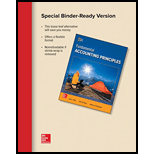
Loose Leaf for Fundamental Accounting Principles
23rd Edition
ISBN: 9781259687709
Author: John J Wild, Ken Shaw Accounting Professor, Barbara Chiappetta Fundamental Accounting Principles
Publisher: McGraw-Hill Education
expand_more
expand_more
format_list_bulleted
Textbook Question
Chapter 4, Problem 13E
Exercise 4-13
Computing the
A1
Use the information in the adjusted trial] balance reported in Exercise 4•11 to compute the current ratio as of the
Expert Solution & Answer
Want to see the full answer?
Check out a sample textbook solution
Students have asked these similar questions
Please FILL THIS OUT!!!!! PLEASE HELP
I am looking for the correct answer to this financial accounting question with appropriate explanations.
Can you solve this financial accounting question with the appropriate financial analysis techniques?
Chapter 4 Solutions
Loose Leaf for Fundamental Accounting Principles
Ch. 4 - Prob. 1DQCh. 4 - Prob. 2DQCh. 4 - Prob. 3DQCh. 4 - Prob. 4DQCh. 4 - Prob. 5DQCh. 4 - Prob. 6DQCh. 4 - 7. Why are the debit and credit entries in the...Ch. 4 - Prob. 8DQCh. 4 - Prob. 9DQCh. 4 - Prob. 10DQ
Ch. 4 - Prob. 11DQCh. 4 - 12. How do reversing entries simplify...Ch. 4 - If a company recorded accrued salaries expense of...Ch. 4 - Prob. 14DQCh. 4 - Prob. 15DQCh. 4 - Prob. 16DQCh. 4 - Prob. 17DQCh. 4 - Prob. 1QSCh. 4 - Prob. 2QSCh. 4 - Prob. 3QSCh. 4 - Prob. 4QSCh. 4 - Prob. 5QSCh. 4 - Prob. 6QSCh. 4 - Prob. 7QSCh. 4 - Prob. 8QSCh. 4 - Prob. 9QSCh. 4 - Prob. 10QSCh. 4 - Prob. 11QSCh. 4 - Prob. 12QSCh. 4 - Exercise 4-1
Extending adjusted account balances...Ch. 4 - Prob. 2ECh. 4 - Prob. 3ECh. 4 - Exercise 4-4 Completing a work sheet Pl The...Ch. 4 - Exercise 4-5 Determining effects of closing...Ch. 4 - Prob. 6ECh. 4 - Exercise 4-7 Preparing a work sheet and recording...Ch. 4 - Prob. 8ECh. 4 - Prob. 9ECh. 4 - Prob. 10ECh. 4 - Prob. 11ECh. 4 - Prob. 12ECh. 4 - Exercise 4-13 Computing the current ratio A1 Use...Ch. 4 - Prob. 14ECh. 4 - Prob. 15ECh. 4 - Prob. 16ECh. 4 - Prob. 17ECh. 4 - Problem 4-1A Applying the accounting cycle C1 C2...Ch. 4 - Prob. 2APSACh. 4 - Prob. 3APSACh. 4 - Prob. 4APSACh. 4 - Problem 4-5A Preparing trial balances, closing...Ch. 4 - Prob. 6APSACh. 4 - Prob. 1BPSBCh. 4 - Prob. 2BPSBCh. 4 - Prob. 3BPSBCh. 4 - Prob. 4BPSBCh. 4 - Prob. 5BPSBCh. 4 - Prob. 6BPSBCh. 4 - Business Solutions P2 P3 (This serial problem...Ch. 4 - Prob. 1GLPCh. 4 - Prob. 2GLPCh. 4 - Prob. 3GLPCh. 4 - Prob. 4GLPCh. 4 - Prob. 5GLPCh. 4 - Prob. 1BTNCh. 4 - Prob. 2BTNCh. 4 - Prob. 3BTNCh. 4 - Prob. 4BTNCh. 4 - Prob. 5BTNCh. 4 - Prob. 6BTNCh. 4 - Prob. 7BTNCh. 4 - Prob. 8BTNCh. 4 - Prob. 9BTN
Knowledge Booster
Learn more about
Need a deep-dive on the concept behind this application? Look no further. Learn more about this topic, accounting and related others by exploring similar questions and additional content below.Similar questions
- I am searching for the accurate solution to this financial accounting problem with the right approach.arrow_forwardPlease provide the accurate answer to this financial accounting problem using valid techniques.arrow_forwardPlease provide the correct answer to this financial accounting problem using valid calculations.arrow_forward
- Please fill the empty cell in this problem. It is the only thing I need.arrow_forwardPlease explain the solution to this financial accounting problem with accurate principles.arrow_forwardWhat exactly are intangible assets and how are they defined? How are intangible assets different from plant assets?arrow_forward
arrow_back_ios
SEE MORE QUESTIONS
arrow_forward_ios
Recommended textbooks for you
 Accounting (Text Only)AccountingISBN:9781285743615Author:Carl Warren, James M. Reeve, Jonathan DuchacPublisher:Cengage Learning
Accounting (Text Only)AccountingISBN:9781285743615Author:Carl Warren, James M. Reeve, Jonathan DuchacPublisher:Cengage Learning College Accounting, Chapters 1-27AccountingISBN:9781337794756Author:HEINTZ, James A.Publisher:Cengage Learning,
College Accounting, Chapters 1-27AccountingISBN:9781337794756Author:HEINTZ, James A.Publisher:Cengage Learning, Financial And Managerial AccountingAccountingISBN:9781337902663Author:WARREN, Carl S.Publisher:Cengage Learning,
Financial And Managerial AccountingAccountingISBN:9781337902663Author:WARREN, Carl S.Publisher:Cengage Learning, Financial AccountingAccountingISBN:9781337272124Author:Carl Warren, James M. Reeve, Jonathan DuchacPublisher:Cengage Learning
Financial AccountingAccountingISBN:9781337272124Author:Carl Warren, James M. Reeve, Jonathan DuchacPublisher:Cengage Learning Survey of Accounting (Accounting I)AccountingISBN:9781305961883Author:Carl WarrenPublisher:Cengage Learning
Survey of Accounting (Accounting I)AccountingISBN:9781305961883Author:Carl WarrenPublisher:Cengage Learning College Accounting, Chapters 1-27 (New in Account...AccountingISBN:9781305666160Author:James A. Heintz, Robert W. ParryPublisher:Cengage Learning
College Accounting, Chapters 1-27 (New in Account...AccountingISBN:9781305666160Author:James A. Heintz, Robert W. ParryPublisher:Cengage Learning

Accounting (Text Only)
Accounting
ISBN:9781285743615
Author:Carl Warren, James M. Reeve, Jonathan Duchac
Publisher:Cengage Learning

College Accounting, Chapters 1-27
Accounting
ISBN:9781337794756
Author:HEINTZ, James A.
Publisher:Cengage Learning,

Financial And Managerial Accounting
Accounting
ISBN:9781337902663
Author:WARREN, Carl S.
Publisher:Cengage Learning,

Financial Accounting
Accounting
ISBN:9781337272124
Author:Carl Warren, James M. Reeve, Jonathan Duchac
Publisher:Cengage Learning

Survey of Accounting (Accounting I)
Accounting
ISBN:9781305961883
Author:Carl Warren
Publisher:Cengage Learning

College Accounting, Chapters 1-27 (New in Account...
Accounting
ISBN:9781305666160
Author:James A. Heintz, Robert W. Parry
Publisher:Cengage Learning
Financial ratio analysis; Author: The Finance Storyteller;https://www.youtube.com/watch?v=MTq7HuvoGck;License: Standard Youtube License